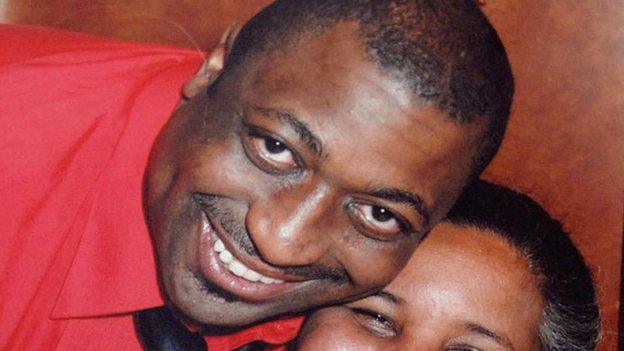George Floyd: Protesters set Minneapolis police station ablaze
- Published
A police station was set on fire in third night of unrest in Minneapolis
A police station in Minneapolis has been set alight during a third night of protests over the death of an unarmed black man in custody on Monday.
A police officer was filmed kneeling on the neck of George Floyd, 46, despite him saying he could not breathe.
President Donald Trump said "thugs" were dishonouring his memory and called on the National Guard to restore order.
The incident has added to anger over police killings of black Americans, including Breonna Taylor in Kentucky.
Mr Floyd's family have demanded that the four police officers implicated in his death face murder charges. Prosecutors have said they are still gathering evidence.
A CNN journalist, Omar Jimenez, and his camera crew were arrested live on air by Minnesota state police officers on Friday morning, external, apparently because they did not move on when instructed.
The team was released an hour later, after the governor apologised for the arrest.
CNN correspondent Omar Jimenez was detained live on air
There have also been demonstrations in other US cities, including New York, Los Angeles, Chicago, Denver, Phoenix and Memphis.
Twitter accused Mr Trump of glorifying violence in a post that said: "When the looting starts, the shooting starts."
What is the latest in Minneapolis?
On Thursday, protesters gathered outside the police department's 3rd Precinct, the epicentre of the unrest.
Officers fired tear gas and rubber bullets in an attempt to disperse the crowd. But the cordon around the police station, which is near where Mr Floyd died, was breached by protesters, who set fire to it and two other nearby buildings as the officers withdrew.

George Floyd's death has reignited criticism of the way black Americans are treated by the police
Minneapolis Mayor Jacob Frey said there had been no choice but to evacuate the police station, adding: "The symbolism of a building cannot outweigh the importance of life, of our officers or the public."
He called the unrest "unacceptable", but recognised there was "a lot of pain and anger".
He spoke after a tweet from Mr Trump blamed Thursday's violence on a "lack of leadership" in Minneapolis and warned that he would send in the National Guard and "get the job done right" if Mr Frey failed to restore order.
National Guard personnel are normally under state control, although they can be put under federal control in emergencies.
Minneapolis protests continue: 'Nobody's listening'
Mr Trump also tweeted: "Any difficulty and we will assume control but, when the looting starts, the shooting starts."
On Friday, the White House Twitter account quoted the president's tweet on looting and shooting.
Twitter placed a "public interest notice" on the message, externals, saying they "violate our policies regarding the glorification of violence based on the historical context of the last line, its connection to violence, and the risk it could inspire similar actions".
The historical context arises from riots in Miami in 1968. A federal task force found that the use of the phrase about looting by the Miami police chief at the time was a prime factor in the discontent that triggered the unrest.

Sirens, smoke, and no end in sight
Analysis by Jessica Lussenhop, BBC senior staff writer, Minneapolis
The "twin cities" of Minneapolis and St Paul, Minnesota heaved with unrest and destruction overnight.
Several areas that have no geographical significance to Floyd's death are now seeing damage, and shops all over the region closed and barricaded their doors.
Protesters in the streets want one thing: the arrest and prosecution of former Minneapolis police officer Derek Chauvin, whose knee was pressed into Floyd's neck for several minutes before he died.
But at a press conference on Thursday, Hennepin County Attorney Mike Freeman was noncommittal, promising only a "robust and meticulous" investigation. Both the FBI and the Minnesota Bureau of Criminal Apprehension are investigating.
It's unclear whether charges would actually bring the violence to a halt.
Developments here are swift and chaotic. Friday morning broke with news that several fires had been set before dawn in Minneapolis and that state police arrested a CNN news crew on live television.
The air in this relatively quiet Midwestern metropolis is filled with sirens and smoke, and it seems there is no end in sight.

Earlier on Thursday, Minnesota Governor Tim Walz had activated the state's National Guard troops, external at the request of the mayors of Minneapolis and the neighbouring city of St Paul, declaring the situation a "peacetime emergency".
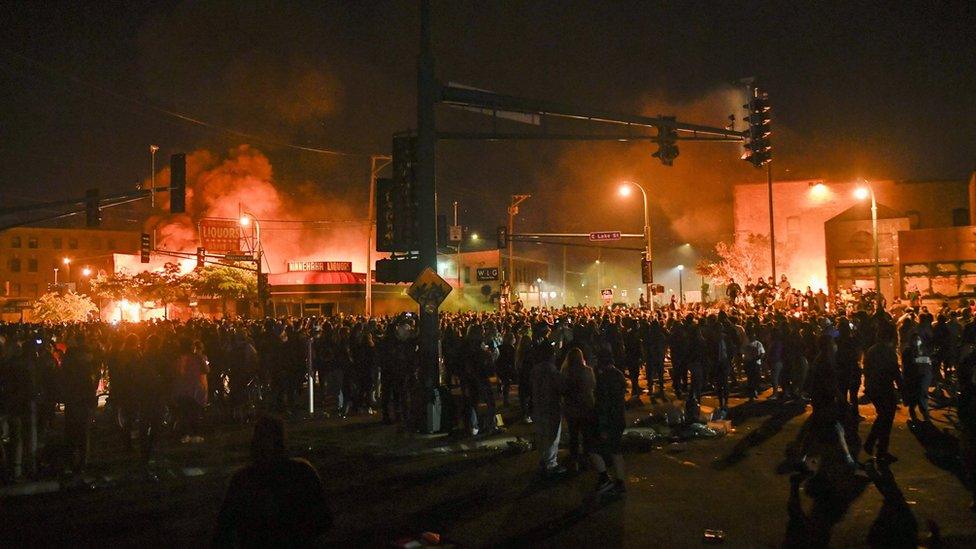
The Minneapolis Police Department said the 3rd Precinct had been evacuated
Calling for peaceful protests, "not more death and destruction", Mr Walz said the looting, vandalism and arson of Wednesday night had damaged many businesses, including ones owned by minorities.
What has been the reaction?
The four policemen involved have been fired, and the mayor has called for criminal charges against the officer seen pinning Mr Floyd.
Speaking through tears, Mr Floyd's brother, Philonise, told CNN on Thursday the officers who "executed my brother in broad daylight" must be arrested and that he was "tired of seeing black men die".
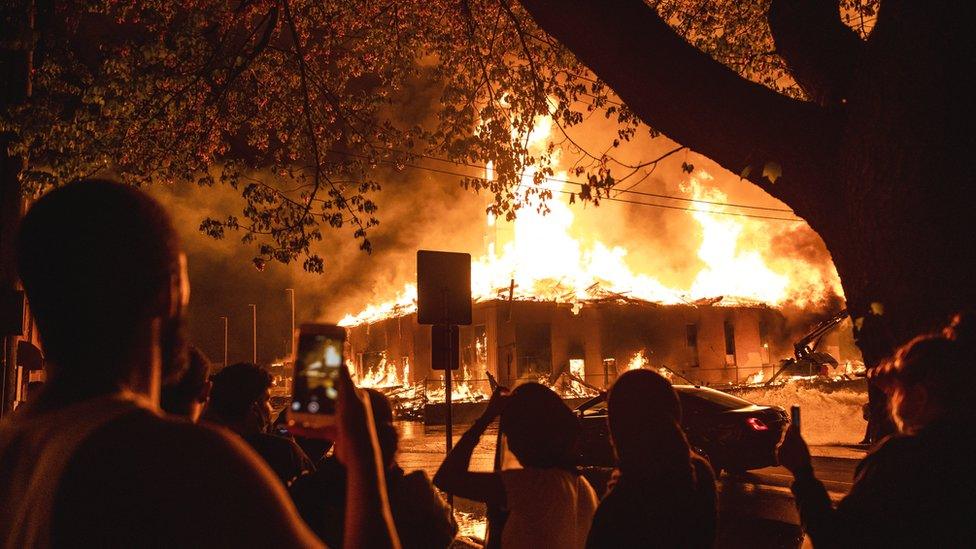
Fires raged overnight close to the site where George Floyd was pinned down by police officers
Mr Trump "was very upset" when he saw the footage of Mr Floyd's death, White House press secretary Kayleigh McEnany told reporters on Thursday.
A number of celebrities, including John Boyega and Beyonce, have also expressed outrage over the incident.
The incident echoes the case of Eric Garner, who was placed in a police chokehold in New York in 2014. His death became a rallying cry against police brutality and a catalyst in the Black Lives Matter movement.
Where else have there been protests?
There were also chaotic scenes during rallies in Denver, Colorado and in Columbus, Ohio.
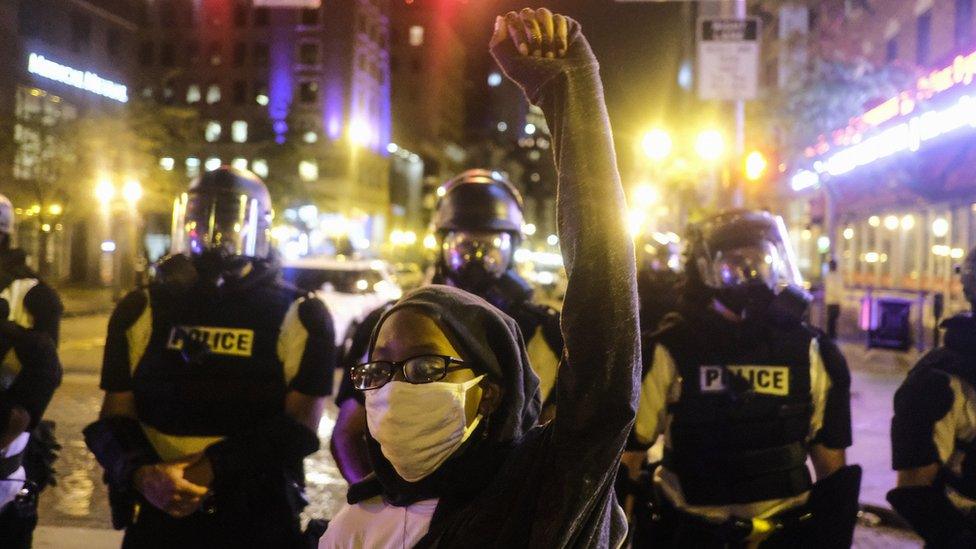
People angered by the death of George Floyd protested in Columbus, Ohio, on Thursday
The statehouse in Denver was put under lockdown after gunfire was heard, while in Columbus demonstrators reportedly broke some of the statehouse's windows before being dispersed by police.
Seven people were also shot in Louisville, Kentucky, at a protest over the death of Breonna Taylor, who was shot by three white police officers in March.
What happened to George Floyd?
Officers responding to reports of the use of counterfeit money approached Mr Floyd in his vehicle on Monday.
According to police, he was told to step away from the car, physically resisted officers and was handcuffed.
Video of the incident does not show how the confrontation started, but a white officer can be seen with his knee on Mr Floyd's neck, pinning him down.
Mr Floyd can be heard saying "please, I can't breathe" and "don't kill me".

George Floyd repeatedly told the police officers who detained him that he could not breathe

The city has identified the four officers involved as Derek Chauvin, Tou Thao, Thomas Lane and J Alexander Kueng.
The Minneapolis Police Officers' Federation said the officers were co-operating with the investigation.
One thing Americans find hard to talk about
The Minnesota police handbook states that officers trained on how to compress the neck without applying direct pressure to the airway can use a knee under its use-of-force policy. This is regarded as a non-deadly-force option.

Are you in the area? If you have any information you are willing to share with the BBC you can get in touch by emailing haveyoursay@bbc.co.uk, external.
Please include a contact number if you are willing to speak to a BBC journalist.
WhatsApp: +44 7756 165803
Tweet: @BBC_HaveYourSay, external
Send pictures/video to yourpics@bbc.co.uk, external
Please read our terms & conditions and privacy policy
- Published28 May 2020

- Published28 May 2020
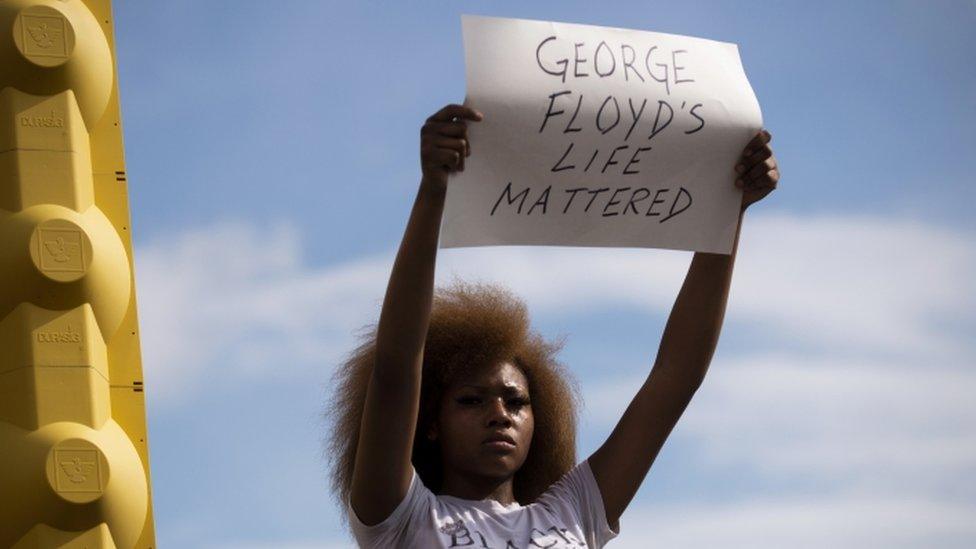
- Published28 May 2020

- Published17 July 2019
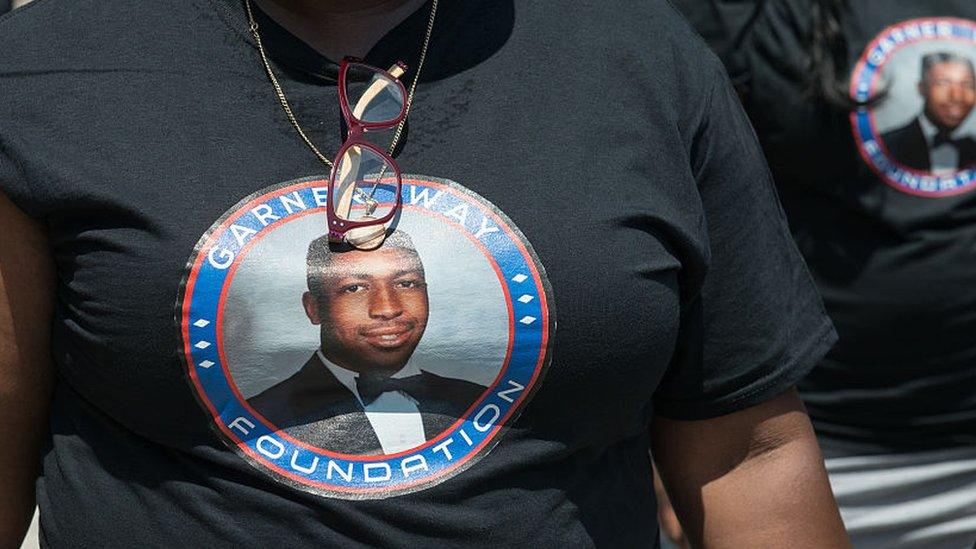
- Published19 August 2019
